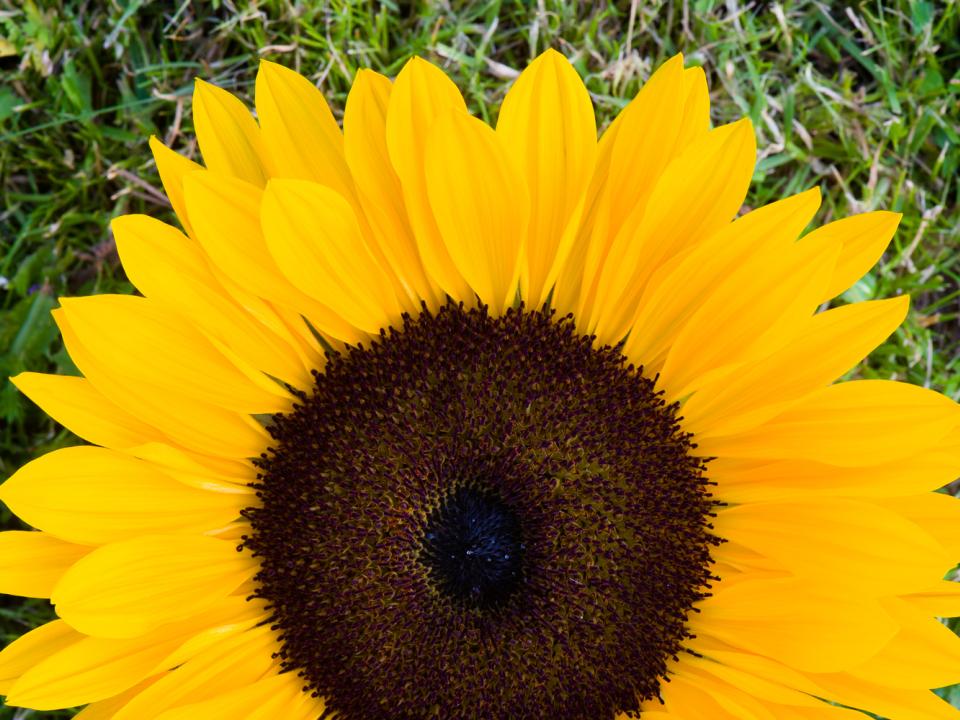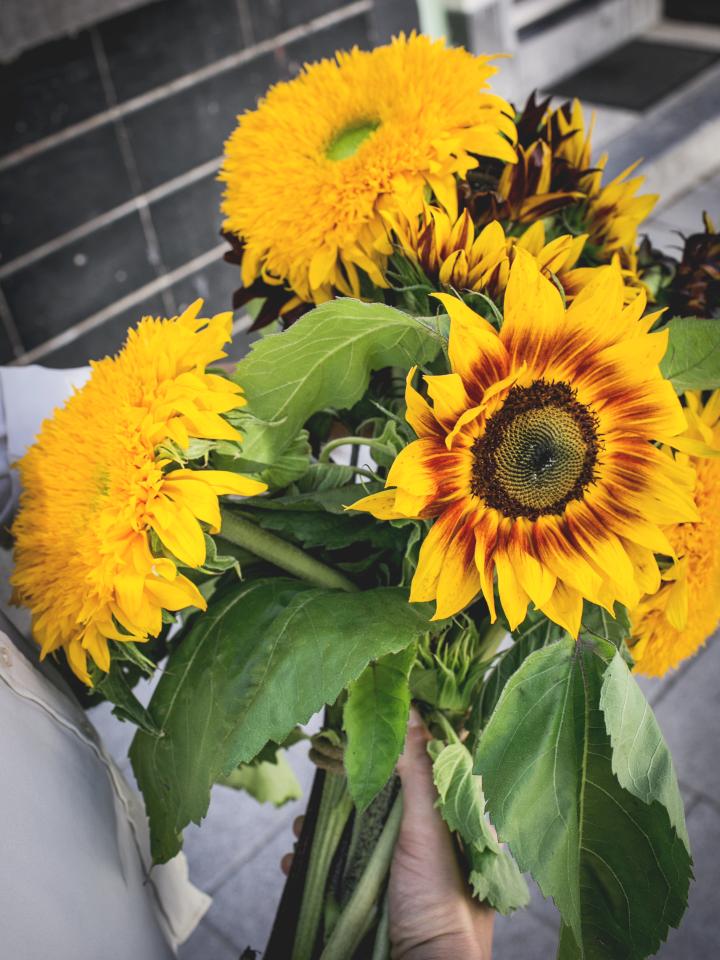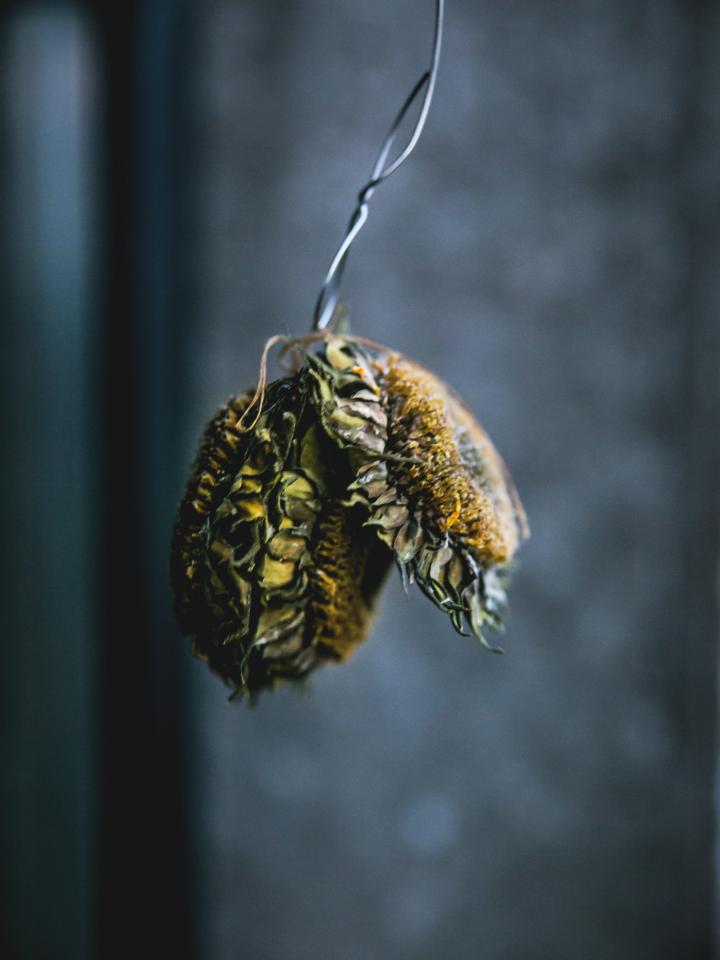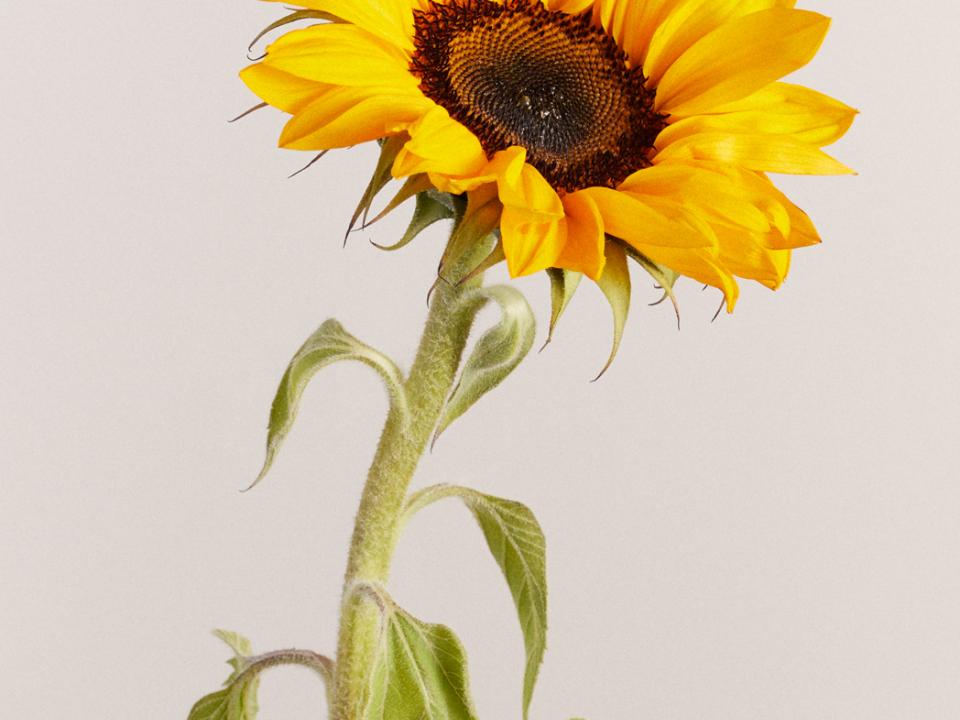SUNFLOWER: CHARACTERISTICS AND FLOWERS
Sunflowers are characterised by long, thick, hairy stems with large, often yellow, flowers. The flowers have brown, yellow or green centres. Sunflowers can grow up to 4 metres tall and belong to the composite family (Asteraceae), which also includes flowers such as Marguerite daisy and yarrow. The official name of the sunflower is Helianthus, a combination of the Greek helios (sun) and anthos (flower).
We know the sunflower mainly as a yellow beauty, but there are also orange, brown, cream and dark red versions. There is also plenty of variation when it comes to shape: sunflowers with large or small flowers, with a single row of petals or with several whorls. Whichever appearance you choose, the sunflower guarantees a sunny summer feeling. Sunflowers generally flower from summer until the first night frost (between July and October), so are true summer bloomers.
WHY DO SUNFLOWERS FACE THE SUN?
What's remarkable about the growth habit of sunflowers is that they are heliotropic. Growing sunflowers face the sun, or rather, the flower itself does not move, but the direction of the stem varies. During the day, the eastern part of the plant grows faster and at night the western part. This alternating stem growth makes the growing sunflowers appear to follow the sun. Fully grown sunflowers do not turn with the sun (they are too heavy), but point their flower towards the east all day. As a result, they warm up faster and attract more pollinators, who flock to warm flowers.

SUNFLOWERS VARIETIES
There are more than 70 different varieties of sunflowers. Some species grow to a height of barely 50 centimetres, while others can reach up to 4 metres. There are annual sunflowers and sunflowers as hardy, perennial plants. Discover the most well-known varieties of sunflowers here:
- Helianthus annuus: Helianthus annuus, also known as the ‘common sunflower’ is the most well-known species. This sunflower species is known for its height (1.5 to 3 metres on average) and large flowers. The flowers are usually yellow in colour with usually a brown-black heart. However, there are also varieties with other colours, such as orange and red-brown. The five species below are the best-known varieties of Helianthus annuus:
- Giant sunflower: the giant sunflower, also known as Helianthus annuus giganteus, is a well-known variety within Helianthus annuus. They are perennial plants that, compared to other sunflower species, grow particularly tall (2-4 metres high). They have large flower heads and longer-than-average stems.
- Dwarf sunflower: dwarf sunflowers, also called ‘compact sunflower’ or ‘dwarf sunflower’, are annual plants that are a lot smaller in size than the standard sunflower. They include many varieties: from small to large, from yellow to orange and red. Each variety has its own sunny look. Dwarf sunflowers usually grow between 60-90 centimetres tall. Being more compact, they are ideal for balconies and small gardens.
- Helianthus annuus ‘lemon queen’: this is a perennial sunflower with somewhat smaller, bright yellow flowers. They don't look like the standard sunflower, and therefore stand out. They grow up to 2 metres high and take up quite a lot of space because of the many flowers.
- Helianthus annuus ‘sunfinity’, ‘sunblast’ and ‘sunsation’: these are annual sunflowers that you buy as plants and don't have to sow yourself. You see this species in garden centres regularly. These sunflowers grow about 50cm -2.50m tall.
- Double-flowered sunflower: the double-flowered sunflower is an annual plant. This species is even less known than others, but nevertheless beautiful to look at! The double-flowered sunflower comes in yellow, orange, red and pink. They have flowers with extra rows of petals, giving them a fuller look than the other varieties. The height of double-flowered sunflowers ranges from 60 cm to 2 metres.
- Helianthus decapetalus: Helianthus decapetalus, also known as marsh sunflower, is a perennial plant. This species is characterised by somewhat smaller, bright yellow flowers and elongated, narrow leaves. This perennial plant returns every year and grows about 1.50 metres tall. Helianthus decapetalus often grows in moist, swampy soil and is popular in wildflower and bog gardens.
- Helianthus tuberosus: Helianthus tuberosus, better known as the Jerusalem artichoke, is an outlier when it comes to sunflowers. Known for its edible tubers, this perennial is cultivated for its culinary uses and robust appearance. Jerusalem artichoke proliferates and generally grows smaller than Helianthus annuus (up to about 2.5 metres tall). The flowers of Jerusalem artichoke are bright yellow with a brownish-yellow centre. The flowers are smaller than those of Helianthus annuus.
HOW TO CARE FOR CUT SUNFLOWERS IN A VASE
Have you brought home a beautifully bright bouquet of sunflowers? Then you'll want them to last for as long as possible. The care tips below will help you to care for your sunflowers in the best way:
- Trim the stems of the sunflowers at an angle with a sharp knife or flower scissors.
- Remove excess leaves from the stems so that leaves don't get into the vase water and cause bacterial growth.
- When choosing your vase, consider the weight of the sunflowers. They're heavy, so choose a sturdy vase.
- Put the flowers in a clean, preferably glass vase with a small layer of warm water. Don't give sunflowers too much water, as the stems will become mushy and the flowers will droop. Have your sunflowers started drooping anyway? Then pour some hot (not boiling) water into the vase.
- Add a little cut flower food to prolong the life of your sunflowers. Don't have any flower food in the house? Then add a drop of bleach (chlorine) to the water, being aware of children and pets.
- Change the vase water regularly and top up if necessary. Sunflowers are thirsty.
- Place the vase in a cool spot away from the fruit bowl and not in full sun or a draught.

PLANTING SUNFLOWERS IN YOUR GARDEN
With their sunny look, sunflowers are an asset to any outdoor space. If you're hoping to sow sunflower in the open ground or in a pot, check out the tips below for sowing and best positioning and care of sunflowers. Sunflower seeds germinate very easily. It's an excellent task to do with children, so you can see how quickly the plant grows together.
- Annual sunflowers are best sown in April or May, when the chance of severe frost has passed.
- Sunflowers love the sun (it's in their name, after all). Choose a sunny, sheltered spot (along a hedge or fence, for example). Sunflowers turn towards the east, so you should preferably plant them in a spot where you have the best view of the sunflowers (rather than your neighbours).
- Sunflowers can grow quite tall, so make sure you have enough space.
- Although sunflowers thrive in almost any type of soil, they prefer slightly acidic to neutral soil with a pH between 6 and 7.5 (you can measure this with a pH meter). If your soil is too acidic, you can add lime. Is the pH level too high? Then use acidic compost.
- Before planting the sunflower seeds, mix compost or fertile soil into the soil. Sunflowers like nutritious soil.
- Put the seeds about 1.5-2 centimetres deep into the soil, spaced about 30-40 centimetres apart. Then water them adequately.
- Are you planting young sunflower plants instead of seeds? Then check out this step-by-step plan for planting garden plants.
- Beware of snails, as they love young sunflower plants. Protect sunflowers from slugs by adding copper rings to the young plants at the bottom or by placing dry, sharp surfaces (such as eggshells and small stones) around the plants. Coffee grounds can also help protect against slugs and snails.
- Water sunflowers sufficiently during a dry and warm period. Ensure they have good drainage, as sunflowers do not like soil that is too wet.
- As soon as flowers appear on the stems, you can give the sunflowers potassium-rich fertiliser (e.g. tomato fertiliser).
- When the sunflowers grow taller than 1 metre, it's wise to give them supports so they don't fall over under their own weight. This can be done with a stick or other similar material.
SOWING SUNFLOWERS IN POTS
Are you sowing sunflowers in a pot? Then stick to about one seed per pot that has a diameter of 7.5 cm. Press the seed about 2 centimetres into the pot with good potting soil and give it plenty of water. Cover the pot with cling film and put it in a bright spot that's not too warm. You can then put the germinated plants in fertile soil after the frosts have passed, or repot the plants into a larger pot.
WHEN AND HOW SHOULD YOU PRUNE SUNFLOWERS?
Pruning sunflowers is not always necessary for their growth and flowering. They are easy-to-maintain plants. Whether you should prune your sunflowers, and when, depends on the species (annual or perennial) and the purpose (if you're growing them as bird food, to put in your vase, for edible purposes, etc.).
- Want grow sunflowers to cut and have them shine in your vase? Cut them at an angle the moment the sunflower is almost open, preferably in the early morning or late evening. The flowers wilt faster if you harvest them when it's warm.
- If you want to prune your sunflowers because they have grown extremely tall and you're hoping for several flowers for one stem, it's best to prune in June.
- Have your annual sunflowers finished flowering? Then just leave them in place. Birds such as sparrows and finches love them. In late autumn, just before winter, you can pull them out of the ground and compost them.
- Have your hardy perennial sunflowers finished flowering? After your perennial sunflower has fully flowered and you have harvested the seeds or they've been eaten by birds, you can do two things:
- Prune the stems back to about 10-15 centimetres above the ground. This prevents the long, dead stems from falling over during the winter. After pruning, you may want to apply a generous layer of mulch (organic fertiliser) to protect the sunflower's roots from frost.
- Perennial sunflowers can also survive without much pruning. You can leave dead plant parts as natural shelter for insects and to give birds a chance to eat from the seeds throughout the winter. In spring, before new growth starts, you can then remove the any dead parts. This way (not pruning in autumn) works best if the stems aren't too tall or need support from canes.
WHAT SHOULD YOU DO WITH SPENT SUNFLOWERS?
Have your annual sunflowers in your vase or garden finished flowering out? Don't throw them away! You can still enjoy the flowers even afterwards. You can, of course, leave garden plants as food for the birds and protection for overwintering insects, whether on the plant or off (such as hanging a dead sunflower head underneath a bird feeding station). You can also let sunflowers dry upside down, spray them with some hairspray and use them for decoration.

SUNFLOWER MEANING AND SYMBOLISM
The sunflower has several symbolic meanings, but the most common are ‘sun’, ‘zest for life’ and ‘happiness’. Sunflowers are often associated with the sun because of their bright, yellow petals that resemble sunbeams and the plant's ability to turn towards the sun. This ability (always seeing the sunny side of life) also causes the flowers to be seen as a symbol of zest for life, constancy, positivity and happiness.
In Greek mythology, the sunflower was associated with the god of (among other things) the sun and light, Apollo. In Greek mythology, nymph Clytia falls madly in love with the sun god Apollo. This love was not reciprocated and Clytia died of misery. She turned into a sunflower and constantly turned with the sun to see her sun god.
WHERE DO SUNFLOWERS ORIGINALLY COME FROM?
The sunflower is native to North and Central America. Indigenous peoples ate the seeds from the flower, which are rich in nutritious oil. Later, in the late 16th century, the sunflower was brought to Europe by European explorers. Today, the sunflower is grown worldwide as an ornamental plant, food crop and for oil production.
ARE SUNFLOWERS EDIBLE?
Yes, sunflowers are edible and have been used for centuries for culinary purposes for both humans and animals. It's not the petals themselves that are eaten, but the seeds found in the centre of the flowers.
For many animals, such as birds and squirrels, sunflower seeds are a real treat and provide plenty of nutrients and energy. Young leaves and stems of the sunflower are also edible for some animals, such as chickens. Snails also like young sunflower plants, but they are often a less popular guest.
Among humans, sunflower seeds are a particular favourite, often roasted and eaten as a snack. They are rich in nutrients including vitamins, fats and proteins. Roasted sunflower seeds are also often used in salads, or in bread and muesli. In addition, sunflowers are used for oil. Sunflower oil is pressed from the seeds of the sunflower and the neutral-tasting oil is mainly used for baking, frying and deep-frying.




















